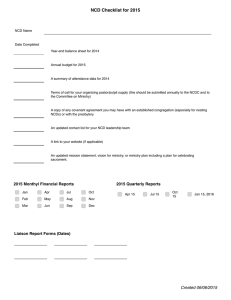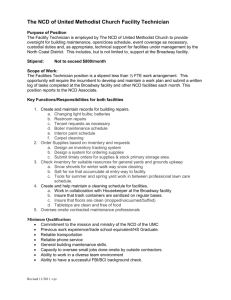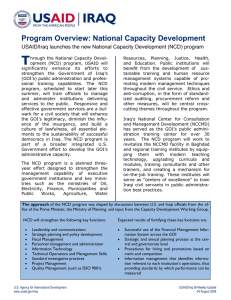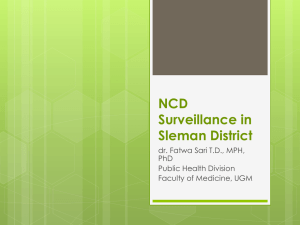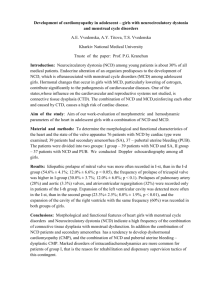NCD Action Plan Brazil: 2011- 2022
advertisement
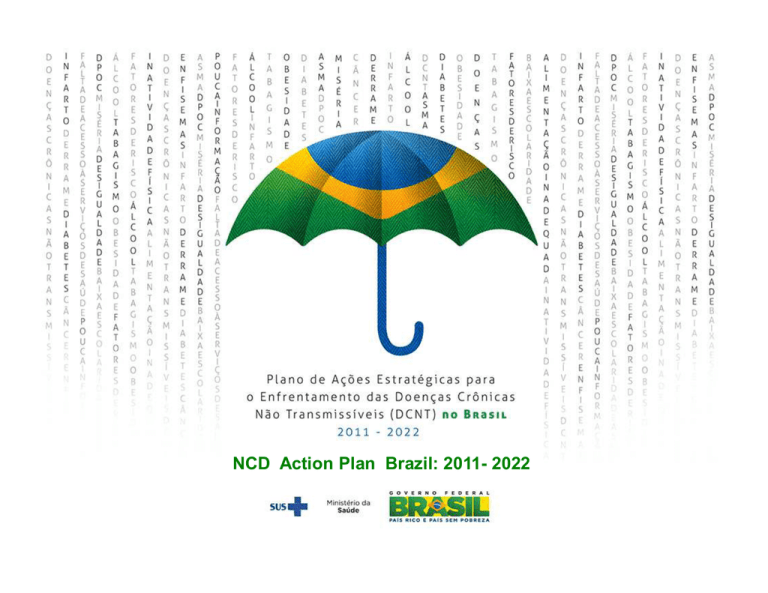
NCD Action Plan Brazil: 2011- 2022 Summary 1. Background – NCD mortality 2. Leadership and multi-sectoral action 3. NCD Action Plan 2011- 2022 4. Surveillance and Monitoring 5. Prevention and Health Promotion • Tobacco • Salt Reduction Agreements • Physical Activity Policies • Alcohol regulation 5. Treatment and access to medicines 6. Conclusion NCD Mortality •72% of deaths in 2011 • 20% reduction mortality 300 Reduction of Chronic Diseases 2000 – 2011 – 2.5% per year Taxa padronizada (100.000 hab.) 250 200 Neoplasias (Redução 0,9% ao ano) 150 Diabetes Mellitus (Redução 1,5% ao ano) 100 Doenças Cardiovasculares (Redução 2,6% ao ano) 50 Doenças Respiratórias (Redução 3,3% ao ano) 0 2000 2001 2002 2003 2004 2005 2006 2007 2008 2009 2010 2011 Ano Leadership and multi-sectoral action Mobilization NCD Plan The NCD Plan has intersectoral participation in the Plan elaboration: • About 20 sectors participated in the planning of the NCD Action Plan. (Education, Sports, Finance, Communication others...) • And: NGOs, Universities, Civil Society, private sector. The actions in the Plan include direct responsibilities of the Ministry of Health and also the roles of other sectors. The plan was widely disseminated in several meetings and conferences. NCD Action Plan 2011- 2022 Prevention and Health Promotion Tobacco use Physical inactivity NCD Harmful use of alcohol Unhealthy diets Integral Care Surveillance, monitoring and evaluation Actions in progress I -NCD Surveillance and Prevention in Brazil NCD Surveillance and Prevention in Brazil 2005 Surveillance, control and prevention of NCD VIGITEL 2006 2006 VIGITEL 2007 2007 VIGITEL 2008 2008 NCD Guidelines POF 2008-09 PeNSE 2009 VIGITEL 2009 2009 VIGITEL 2010 2010 VIGITEL 2011 NCDs Action Plan 2011 PeNSE 2012 2012 2013 National Health Survey VIGITEL 2012 National Health Survey: 2013 - In 2013 a National Health Survey (household) was made in order to produce national data on health status, risk behaviors (including PA monitoring) NCD, health services access, financing, others; - Include GATS reduced – TQS (Adults Population > 18 years old). -This survey will be the base line to all NCD targets. - Sample: 80.000 households - Representation: Brazil, Regions, States, Capitals, urban and rural. - Include anthropometric measurements, blood pressure testing laboratories, urinary sodium and iodine excretion. VIGITEL – Risk factor for NCD Monitoring System of Risk and Protective Factors for Non Communicable Chronic Diseases by Telephone Survey Periodicity: annual 2006 to 2014 Sample: Total of 54 Thousand Blocks of Investigation interviews > 18 years Alcohol consumption (2000 in 27 State Capitals) Tobacco use Dietary habits Advantages: Low cost Physical Activity and speedy results Weight/Height Hypertension/Diabetes Other indicators Vigitel Prevalence of risk and protective factors for NCDs in the capitals of Brazil according to schooling, VIGITEL 2013 35.0 32.9 31.0 31.0 30.0 28.0 25.8 25.0 23.3 22.1 21.1 19.7 20.0 20.3 0a8 17.5 16.4 15.3 15.0 16.2 9 a 11 12 y más 15.0 12.9 12.8 11.3 10.3 10.0 7.4 5.0 0.0 Tabagismo atual Consumo abusivo de álcool Consumo de carne com excesso de gordura Consumo regular de refrigerantes Inatividade física Total II - Prevention and Health Promotion Health Academy Program: The Health Academy units are spaces to promote physical activity and other health promotion activities for the population. 4000 Health Academy Program units will be built. 2014 - U$ 150 million invested Health Program Academy School Health Program Partnership between the Ministry of Education and the Ministry of Health Objective - Integral action for the health of children and adolescents in public schools. Promote PA, adequate nutrition, alcohol and tobacco prevention). Implemented in 4,700 municipalities in Brazil. 2012/2013 - Health in school mobilization week: Prevention of obesity in children and adolescents mobilization - 12 million students aged between 5 to 19 y. Communication Plan for NCDs Media campaigns Campaign on smoking prevention Watch the weight Exhibition (Partnership with the artist Siron Franco) Stimulating fish consumption (Ministry of Fishery) Living well is living with health Program Media campaigns with private sector partners • ABRAS (Brazilian Association of Supermarkets) Campaign • Pilot campaign held in three states to incentive the reduction of salt consumption ABAP Campaign - Brazilian Association of Advertising • Campaign “The future is promising. I want to get there well.” • Movement that encourages healthy habits • Media campaign funded by private companies • Published in Magazines, radio, TV, newspapers. Salt Reduction Agreements Ministry of Health, ABIA (Brazilian Food Industry Association) – voluntary agreements with industry association to reduce the sodium content of processed foods. 1st phase (April, 2011) Instant pastas Sliced breads Buns 3rd phase (August, 2012) Cookies and biscuits Margarines Breakfast cereals Salt-based condiments 2nd phase (October, 2011) French bread Potato chips Corn snacks Cakes and cake mixes 4th phase (November, 2013) Breaded meats Hamburgers Sausages Bologne Hams Mozzarella cheese Cheese spreads Hotdogs Soups Agreement Private Schools Healthy School Cafeterias Agreement between Ministry of Healt and the National Federation of Private Schools Healthy school cafeterias promoting a healthy diet (guide for healthy diet in schools). Legislative measures - Laws Tobacco Law no 12.546, December 14/ 2011 and May 31, 2014 Prohibits smoking in collective space, increases health warnings on cigarette packs, increased prices of cigarettes Alcohol Law nº 11.705/2008 - “Dry Law - prohibits driving motor vehicles after consuming alcohol (any amount of alcohol). 2012 – New Law - increases penalties and defines new evidence for punishment of motorists who drink (video and testimonial evidence) Actions in progress III – Integral Health Care Integral Health Care • Prevention, diagnostics and treatment of cervical and breast cancer • Popular Drugstore program: medications for hypertension, diabetes and asthma. • Health at all times: Urgency Care Network, Emergency Ambulances (SAMU 192), Acute Myocardial Infarction (AMI) Care Network, Home Care Service. • Healthcare Network for Chronic Diseases. NCD Brazilian Plan targets 2011- 2022 The goals of the NCD Plan include reducing mortality and risk factors: • Reducing premature death rate (<70 years) by NCD in 2% a year • Reducing the prevalence of obesity in children and adolescents • Detaining the increase of obesity in adults • Increasing the prevalence of physical activity in leisure time • Decreasing Physical Inactivity in 10% • Increasing fruit and vegetable consumption • Reducing the prevalence of harmful alcohol consumption • Reducing the average salt intake • Reducing tobacco prevalence Possible to achieve - Steady - Or will be measure next survey Difficult to achieve Conclusion NCD Action Plan is a commitment of the Brazilian Government Organization of the Surveillance, Health Promotion and Disease Prevention Partnerships for health promotion – voluntary agreements: reduction of salt, media Advances in the laws– tobacco and alcohol (need to advance in other fields, as food marketing, tax incentives to healthy foods and disincentives to unhealthy foods) Advances in health care– free medicines, prevention of cervical and breast cancer, urgency care (AVE, IAM), primary health care Next step - to involve partners in monitoring and evaluation http://portal.saude.gov.br/portal/saude/profissional/area.cfm?id_area=1818 Thank you! Deborah.malta@saude.gov.br Patricia.jaime@saude.gov.br
